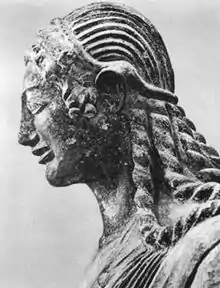This is a list of Etruscan names for Greek heroes. It is a partial list of the names in the list of Etruscan mythological figures.
Names
| Greek name | Etruscan name | Notes |
|---|---|---|
| Achilles | Achle, Achile[1] | Legendary hero of the Trojan War |
| Actaeon | Ataiun[2] | |
| Admetus | Atmite[3] | |
| Adonis | Atunis[3] | |
| Agamemnon | Achmemrun[1] | Legendary king of Mycenaean Greece |
| Aitolos | Etule | Confused with his brother, Epeios, who built the Trojan horse[4] |
| Ajax, son of Telamon Ajax, son of Oileus | Aivas Tlamunus, Aivas Vilates | also Eivas or Evas[5] |
| Amphiaraus | Hamphiare, Amphare[6] | Legendary seer |
| Amycus | Amuce, Amuche, Amuke [2] | The Greek legendary figure of the Argonauts myth |
| Asklepios | Esplace[4] | Legendary healer |
| Atlas | Aril[2] | |
| Capaneus | Capne, Kapne[3] | |
| Castor | Castur[3] | |
| Daidalos | Taitle[7] | |
| Dios Kouroi ("sons of Zeus") | Tinas cliniar, "sons of Tina" | Designating the twins[8] |
| Elpenor | Velparun[9] | |
| Eteocles | Evtucle, [Ev]thucle[4] | |
| Herakles | Hercle, Hercele, Herecele, Herkle, Hrcle[6] | |
| Icarus | Vikare[10] | Son of Taitle |
| Iolaos | Vile, Vilae[9] | Nephew of Hercle |
| Jason | Easun, Heasun, Heiasun | |
| Kallinikos | Calanice | Greek name of Hercle[3] |
| Lynceus | Lunc, Lnche[11] | |
| Meleager | Meleacr[12] | |
| Menelaus | Menle | The hero of Trojan War fame[12] |
| Nestor | Nestur[13] | |
| Odysseus | Uthste | |
| Orpheus | Urphe[1] | |
| Orestes | Urusthe[1] | The Homeric legendary character |
| Palamedes | Palmithe, Talmithe[13] | |
| Patroclus | Patrucle[13] | |
| Peleus | Pele[13] | |
| Perseus | Perse, Pherse[14] | |
| Phaon | Phaun, Faun, Phamu[14] | |
| Phoinix | Phuinis | The friend of Peleus[14] |
| Prometheus | Prumathe[15] | |
| Polydeuces (Pollux) | Pultuce, Pulutuce, Pulutuke, Pultuke[15] | One of the mythological twins |
| Rhadamanthys | Rathmtr | the Greek mythological character, judge of the dead.[15] |
| Sisyphus | Sispe, Sisphe[16] | The legendary king |
| Telamon | Telmun, Tlamun, Talmun, Tlamu[7] | A legendary Argonaut |
| Teucer | Techrs | The Trojan War hero[7] |
| Theseus | These | |
| Tiresias | Teriasals, Teriasa | Legendary blind prophet[7] |
| Tyndareus | Tuntle[17] | |
| Tydeus | Tute[17] |
See also
Notes
- 1 2 3 4 The Bonfantes (2002), page 192.
- 1 2 3 The Bonfantes (2002), page 194.
- 1 2 3 4 5 The Bonfantes (2002), page 195.
- 1 2 3 The Bonfantes (2002), page 198.
- ↑ The Bonfantes (2002), page 193.
- 1 2 The Bonfantes (2002) page 199.
- 1 2 3 4 The Bonfantes (2002), page 206.
- ↑ Swaddling and Bonafante (2006) page 78.
- 1 2 The Bonfantes (2002), page 210.
- ↑ Swaddling & Bonfante page 42.
- ↑ The Bonfantes (2002), page 200.
- 1 2 The Bonfantes (2002), page 201.
- 1 2 3 4 The Bonfantes (2002), page 202.
- 1 2 3 The Bonfantes (2002), page 203.
- 1 2 3 The Bonfantes (2002) page 204.
- ↑ The Bonfantes (2002), page 205.
- 1 2 The Bonfantes (2002), page 208.
References
- Bonfante, Giuliano; Bonfante, Larissa (2002). The Etruscan Language: an Introduction. Manchester: University of Manchester Press. ISBN 0-7190-5540-7. Preview available on Google Books.
- De Grummond; Nancy Thomson (2006). Etruscan Mythology, Sacred History and Legend: An Introduction. University of Pennsylvania Museum of Archaeology. ISBN 1-931707-86-3. Preview available on Google Books.
- Dennis, George (1848). The Cities and Cemeteries of Etruria. London: John Murray. Available in the Gazetteer of Bill Thayer's Website at
- Leland, Charles Godfrey (1892). Etruscan Roman Remains in Popular Tradition. London: T. Fisher Unwin. Downloadable Google Books, online at .
- Pallottino, M. (1975). The Etruscans. London: Penguin Books.
- Richardson, Emeline Hill (1976) [1964]. The Etruscans: Their Art and Civilization. Chicago: University of Chicago Press. ISBN 0-226-71234-6.
- Swaddling, Judith & Bonfante, Larissa (2006). Etruscan Myths. University of Texas Press. ISBN 0-292-70606-5. Preview Google Books.
- Thulin, Carl (1906). Die Götter des Martianus Capella und der Bronzeleber von Piacenza. Alfred Töpelmann. A German-language book, downloadable from Google Books.
This article is issued from Wikipedia. The text is licensed under Creative Commons - Attribution - Sharealike. Additional terms may apply for the media files.
